Seventeen Kinds of Wallpaper Patterns




We find such repeated patterns on wallpaper everywhere in our daily life. Have you considered how many kinds of repetitions there are for patterns on a plane? Do you think there are five or six kinds? No, there are seventeen! We can show this using the mathematics of group theory. The following tables show examples in traditional Japanese patterns:
(A) Without rotations.
| p1 |  (Bingata) |
pm | 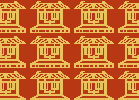 (Yakata-Mon) |
| pg | 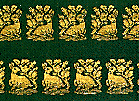 (Hana-Usagi-Kinran) |
cm | 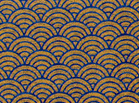 (Seikaiha) |
(B) With rotations of 180 degrees. Without rotations of 90, 60 degrees.
| p2 |  (Ariso-Donsu) |
pmm | 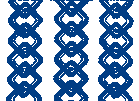 (Yoshiwara-Tsunagi) |
| pgg | 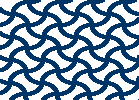 (Fundo-Tsunagi) |
cmm |  (Takeda-Bishi) |
| pmg | 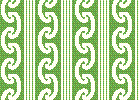 (Shikan-Jima) |
(C) With rotations of 90 degrees.
| p4 |  (Rokuyata-Koshi) |
p4m | 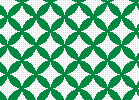 (Sippo-Tsunagi) |
| p4g | 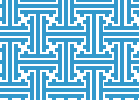 (Sayagata) |
(D) With rotations of 120 degrees. Without rotations of 60 degrees.
| p3 |  (Onaga-Mitsudomoe) |
p31m | 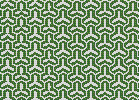 (Bisyamon-Kikko) |
| p3m1 | 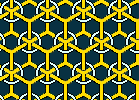 (Kasane-Kikko-ni-Wa) |
(E) With rotations of 60 degrees.
| p6 |  (Kagome) |
p6m |  (Asanoha) |
Above we have shown the mathematical symbols to distinguish the seventeen kinds of patterns and representative traditional Japanese patterns.
For long, I could not check an example of type p3 among traditional Japanese patterns. However, in the end of 2002, Professor Amiko Tone and Professor Sezo Kondo at Kyoto Furitsu University informed me that examples of type p3 among traditional Japanese patterns actually exist. I express thanks for both professors.
In this table we describe the Japanese nomenclature for the names of the patterns.
| p1 | Bingata | gata = shape, Bingata = a generic name of traditional dyed patterns of the Okinawan Islands |
| pm | Yakata-Mon | Yakata = big house, Mon = pattern, Yakata-Mon = a symbol of the Ise Shrine |
| pg | Hana-Usagi-Kinran | Hana = flower, Usagi = rabbit, Kinran = the name of method of weaving with golden thread in the texture |
| cm | Seikaiha | Sei = blue, kai = ocean, ha = wave |
| p2 | Ariso-Donsu | Ariso = abbreviation of ara-iso, ara = wild, iso = rocky beach, Donsu = the name of method of weaving in texture |
| pmm | Yoshiwara-Tsunagi | Yoshiwara = the name of a downtown area in Edo, Tsunagi = connected objects, Edo = the former name of Tokyo |
| pgg | Fundo-Tsunagi | Fundo = weight for a balance, Tsunagi = connected objects |
| cmm | Takeda-Bishi | Takeda = the name of a daimio (feudal lord) in the 16th century, Bishi = rhombus |
| pmg | Shikan-Jima | Shikan = the name of a kabuki actor, Jima = stripes |
| p4 | Rokuyata-Koshi | Rokuyata = the name of a character in kabuki play, Koshi = lattice |
| p4m | Sippo-Tsunagi | Sippo = seven kinds of treasure, Tsunagi = connected objects |
| p4g | Sayagata | Saya = silk textile with beautiful patterns, gata = shape or pattern |
| p3 | Onaga-Mitsudomoe | O = tail, naga = long, Mitsu = three, Mitsudomoe = the name of a Japanese traditional crest repeated in the pattern |
| p31m | Bisyamon-Kikko | Bisyamon = the name of a Buddhist god, Kikko = carapace of a tortoise |
| p3m1 | Kasane-Kikko-ni-Wa | Kasane = repeated, Kikko = carapace of a tortoise, ni = and, Wa = ring |
| p6 | Kagome | Kago = basket, me = eye or hole |
| p6m | Asanoha | Asa = hemp, no = of, ha = leaf |
The examples shown here of pmg and p4 are related to kabuki plays. The patterns were used not only on the costumes but were dyed on souvenir hand towels and distributed to fans. In particular, the name of Shikan-Jima demonstrating pmg has a double meaning as a joke. Shikan is the name of an actor. (Later he changed his name to Nakamura Utaemon. In Japan sometimes the same name is handed down in a family. Shikan is the second Nakamura Utaemon.) At the same time "shi" means "four" and "kan" means "ring" or "handle"; and "Jima", stirpes: as in the pattern of four stripes and the handle of a chest.
Kasane-Kikko-ni-Wa, the p3m1 example, was often used on noh costumes.
Let us give a more detailed mathematical explanation.
 Back to Tohsuke Urabe Laboratory Back to Tohsuke Urabe Laboratory
|
 Next Page Next Page
|